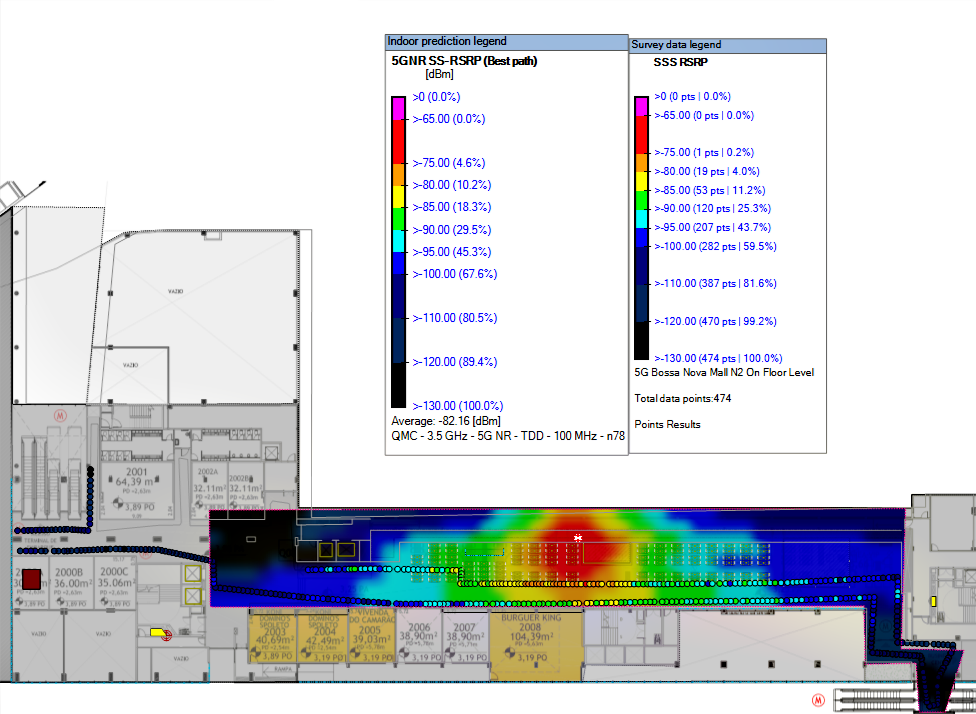How to Design Accurate 5G Networks at 3.5 GHz
Share

Improved coverage and better use of available spectrum are two of the key advantages 5G offers. A properly planned and designed 5G network will support delivery of enhanced mobile broadband applications and experiences, provide more reliable connections for mission-critical communications, and enable the mass deployment of IoT devices.
To capitalize on the benefits 5G offers, the networks that provide coverage indoors must be designed accurately. But planning and designing effective 5G coverage for complex indoor spaces can be much more challenging than existing technologies, like 4G. With so many variables to consider, predicting network performance accurately is the key to deploying a high-quality 5G network end users can rely on.
So, before you tackle any 5G deployment at 3.5 GHz, take a hard look at the prediction software available to support your design process.
An Accurate Network Design Software Eliminates Risk
The accuracy of 5G coverage at 3.5 GHz in any venue is only going to be as good as the software that is used to predict that coverage. Without an accurate software, RF engineers run the risks of delivering a network design that will not perform as needed once it’s installed and activated, and either over-designing or under-designing the network to compensate for variations in the predicted coverage based on wide margins of error.
When a network simulation does not accurately predict how it will perform, once the network is installed, it can lead to very costly troubleshooting, downtime or re-design work. Under-designing the network can create blind spots and negate all the benefits 5G offers. Over-designing the network adds unnecessary equipment costs, complicates deployment and creates more coverage than is needed. Both scenarios can complicate network rollout and add additional costs to a deployment budget.
How can you maximize the accuracy with which you design 5G networks?
You will want to evaluate the features of the software and ensure they are focused on delivering accuracy. Consider:
- 3D Modeling – If the building is not modeled accurately in the software, then the network simulation will not be accurate either. Ensure that the materials you are modeling with are accurate to the real building, that materials have attenuations set for the frequency you’re designing for, scales are properly set, and all walls and surfaces (including inclined) are included in your model.
- Accurate Database of Components – The database you are using to model your building and network should contain accurately modeled materials and parts. Ensure the right materials are available and that the parts in the database are accurately modeled vendor parts – antennas, cables, small cells, and other hardware needed for a deployment.
- Demonstrated accuracy based on stress tests – The software should have a proven history of delivering accurate network simulations and be backed by analytical data and case studies that demonstrate the ability of the software to deliver accurate predictions in a variety of venues, such as stadiums, malls, hotels, and more.
- Coverage Compliance – The survey tool you use to validate the network should have built in, pre-configured metrics that engineers can use to determine whether design goals have been met, and which network operators can use to verify that the design provided meets all specified goals.
You should also consider different prediction methods and their suitability for particular venues, as not all prediction models have the same accuracy. We’re talking about COST 231, VPLE (Variable Path Loss Equation) and Ray Tracing. You can read more about each and their pros and cons in our dedicated blog.
But of course, the most important consideration is the algorithm the software’s prediction engine uses to generate an accurate prediction.
Accuracy in the prediction process should be based on both mean error and standard deviation.
Mean error is a measure of how much measured data deviates from prediction. If one has collected, say, 400 measured points in a venue, then calculates the difference between predicted and measured value, then sums up the difference in each point and then divides with the number of points, one gets the value for average mean error.
Because the difference in each point can be positive or negative, mean error is sometimes close to zero. But that does not mean that the prediction is very accurate, because the difference in one point could be +20 dB and -20 dB in another, and yet average mean error for those two points is zero.
That’s why it’s very important to also know what the standard deviation should be. This is a number that is always positive and points to how much variation of accuracy can be expected in the prediction.
For inbuilding deployments, the algorithm should be delivering prediction results with a standard deviation and absolute margin of error of 3-5 dB. Anything more than that can lead to an over-designed or under-designed network.
If you want to learn more, read about the 6 Ways iBwave Focuses on Prediction Accuracy.
Deployment Data Confirms Accuracy of Predicted Coverage
Ultimately, you won’t know how accurate the tool you use is until after you have deployed your network. Data provided by QMC Telecom earlier this year from a 5G trial network at the Bossa Nova Mall in Brazil demonstrates just how important accuracy is when planning in-building coverage.
As outlined in a recent iBwave white paper, the Bossa Nova Mall trial was designed to demonstrate the efficiency of 5G service at 3.5 GHz in indoor environments, so getting optimal coverage in place in high traffic areas was a priority.
After deployment, QMC Telecom compared the predicted and measured 5G coverage. The results show that the accuracy of the prediction tool QMC Telecom used enabled design and deployment of the optimal network configuration to support all trial coverage requirements.

iBwave Design Prediction Accuracy Confirmed at 3.5 GHz
The prediction tool QMC Telecom used was iBwave Design. As the Bossa Nova Mall example shows, iBwave Design provides the right combination of elements needed to streamline the design of all 5G indoor wireless networks, including deployments at 3.5 GHz.
To enable accurate planning and design, the software offers three prediction models — VPLE, COST 231, and Fast Ray Tracing — that provide different levels of accuracy for different environments. Most of our customers rely on the Fast Ray Tracing prediction algorithm, which is based on Ray Tracing and was developed by iBwave RF engineers in partnership with scholars and experts from the in-building industry.
Download the white paper to learn more about how iBwave Design prediction modeling enabled QMC Telecom to accurately design coverage for its 3.5 GHz trial deployment at the Bossa Nova Mall.
___________________________________________
- Private: How to Design Accurate 5G Networks at 3.5 GHz – November 23, 2022
- How Can Machine Learning Help RF Propagation Analysis? – November 19, 2021
- MIMO and Beamforming: Looking at the Impact on Throughput and Coverage – April 27, 2021
- Private: Power Output & MIMO – Predictive Design – April 23, 2021
- A Deep Dive into iBwave Design Prediction Accuracy Report - November 18, 2024
- At a Glance: What Is New in Wi-Fi 7? - July 4, 2024
- Accurate Prediction Simplifies Private, In-Building 5G Network Deployments - March 1, 2023




















thank you